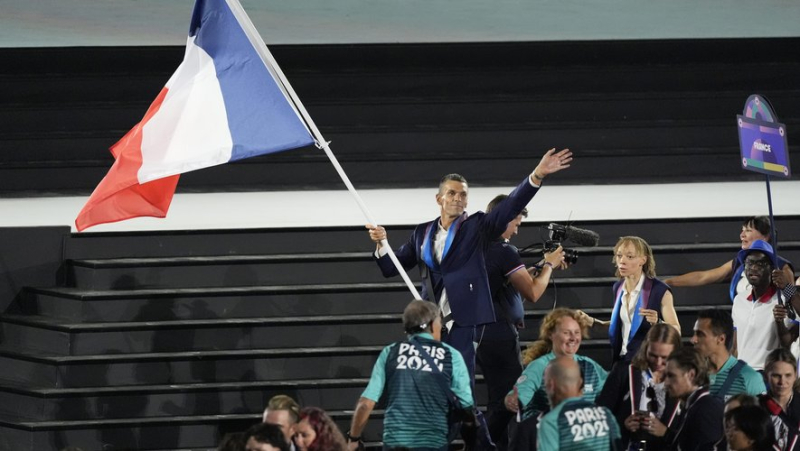Paralympic Opening Ceremony: On Place de la Concorde, the “Paras” Make Their Revolution

Alexis Hanquinquant et les Français ont déambulé dans l'enceinte ouverte de la Concorde. MAXPPP – Andrew Matthews
Plus sobre que sa grande sœur olympienne, la cérémonie d'ouverture des Jeux Paralympiques, qui s'est déroulée ce mercredi 28 août, est restée dans le jus de Paris 2024.
The deluge, the wet shoes, the apocalyptic setting… The chaos of the Olympic Games opening ceremony had its charm. But the Parisian setting under the last rays of the sun and a light breeze, enough to raise the flags of the 168 delegations, still has some charm. Let's even dare to write that the Paralympics experienced the opening ceremony in the most prestigious decorum in the world. Going down the Champs-Élysées to the Place de la Concorde, transformed into an open enclosure, on a floor specially covered with a tarred carpet to facilitate access, was more than well seen. And unprecedented for the athletes, who have never paraded in the heart of a host city.
Les Phryges qui jouent à 1, 2, 3 soleil… C’est pour m’abattre ? 🥹#phryge #ceremoniedouverture pic.twitter.com/B17G1sq5c2
— JulDux ✨ (@Jlngi_) August 28, 2024
“We had to offer a crazy staging, a crazy lighting for these athletes”, says Daphné Burki, head costume designer of the ceremony.
The choice of Concorde is also symbolic. On Wednesday, the Place de la Révolution française also became that of global inclusion.
“Since the beginning of this adventure, we have wanted to carry a very strong ambition. It will be the same for the Paralympic Games", Tony Estanguet, Mr. Paris 2024, promised Midi Libre at the beginning of the week. The first day of the second round of the Olympic adventure sets the scene well.
Fewer highlights, but a crazy decorum
This “Paras” ceremony was a real challenge for Thomas Jolly, the great architect of the two opening ceremonies. He had almost nothing to lose on July 26, as everyone saw the organization crashing at the beginning of the summer. It passed. And Jolly, despite his sometimes slightly provocative tendencies, showed that France could set the bar high, very high. Just like the organization of these Olympic Games. Faced with the popular success of the event, even the most angry acknowledged their misplaced bitterness.
So, on Wednesday evening, it was necessary to keep the cursor on top.
The first thrill is often the most anticipated in this kind of event. It didn't take long to arrive. The "Welcome to Paris" of Théo Curin, one of the faces of French disabled sport for several years, under an explosion of blue-white-red smoke, had its effect.
The show, the choreographies, the interpretation of Non, je ne regrette rien by Édith Piaf by Christine and the Queens ? Everyone will have their own opinion. No position taken from the press stand at the Concorde, we'll leave that to social networks. But the overall performance, undeniably, was a bit more sober than its Olympic sister, less flashy, with fewer scenes and highlights.
An even more symbolic second round
But we can say that the launch of the “Para” rocket is a success. We are counting on the French athletes to put stars back in our eyes over the next ten days. And the challenge is great. Because the landing of the cloud on which the Olympics carried us was too abrupt. Day 1 without Games ? Worse than a hangover. No longer being able to wake up in the morning, flop straight onto the couch and watch Lisa Barbelin adjust her archery sights, marvel at the French BMXers or thrill at Nicolas Gestin in canoeing… Depression. Yet, God knows we love teleshopping.
But let's reassure ourselves, then. Let's rejoice, even. The “Paras” offer us a second round. A new shot of fun. The craze can only grow by discovering disciplines like goalball or boccia.
La performance émouvante de l'artiste Lucky Love au pied de la Concorde ✨
Le direct : https://t.co/3MAKaLC8Ik#Paris2024 #ceremoniedouverture pic.twitter.com/n5Rv42iKX7
— France tv (@FranceTV) August 28, 2024
Because in August, we noticed that sport was doing us good. For two weeks, the madness of the world dissipated a little thanks to the Games. Sport is going even further, over the next ten days, by raising awareness of inclusion, by breaking down the barriers of differences.
But be careful, it is not a question of glorifying disability, which represents 15% of the world's population. Nor of sanctifying it during the “Paras”, even if it is difficult, at first thought, not to think like that. Thomas Jolly wanted this Wednesday evening's show, precisely, to get away from “heroic clichés concerning people with disabilities, because it's not being a hero to take on daily challenges linked to societal and urban barriers”.
The sporting performances, the journey of these athletes will be told. As was done with the able-bodied. Maybe here, and we can't help it, because they remain heroes in spite of themselves, there will be a little something extra, as the other one would say.
Five to light the cauldron!
It's the little game before the ceremony. Who will perform ? Or, who will carry the flame ? Around 11:10 p.m., Florent Manaudou appeared at the bottom of the Champs-Elysées. The five-time Olympic swimming medalist brought the torch into the grounds of the Concorde. It is the first of a relay marked by the presence of Paralympic stars, while Ravel's Bolero accompanied the show. Michael Jeremiasz (French tennis player), Bebe Vio (Italian fencer), Oksana Masters (American, rowing specialist), Markus Rhem (German long jumper), Assia El Hannouni (athletics), Christian Lachaud (former fencer, most decorated Frenchman) Béatrice Hess (swimming, second most decorated athlete in history)… And everything accelerated. There were five of them lighting the Olympic cauldron: the two flag bearers Nantenin Keita (athletics) and Alexis Hanquinquant (triathlon), Charles-Antoine Kouakou (athletics), Elodie Lorandi (swimming) and Fabien Lamirault (table tennis).




